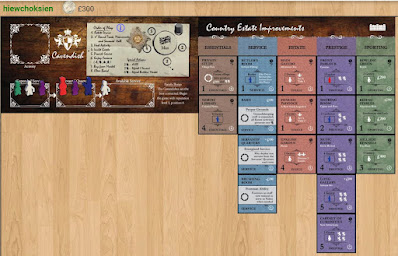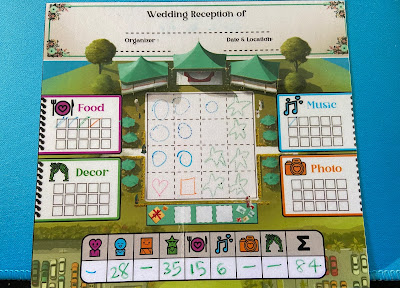The Game
Upin & Ipin is a popular cartoon TV show in Malaysia. It is hot is Indonesia too, and is also aired in several other countries. It was first released in 2007, and now in 2024 it is still going strong. If the twin brothers Upin and Ipin were 5 years old in 2007, they would be 22 now.
Upin & Ipin: Ke Sana Ke Sini the boardgame is based on the characters in the TV series and their village. The game board (above) shows their village. It is a 8 x 6 grid, basically a chess board. You can see roads, but movement is based on the grid, not these roads.
Some squares on the board are homes, shops or other buildings. Those with photos are homes and the photos show who live where. For a kid to enter a home, the host must be at home. You can't enter other people's houses when they are not around. That's basic manners. And this is one of the traditional values the game designer Effendy aims to convey. At the homes and buildings you can collect items with various powers.
These are the item cards. You may carry at most three of them.
Upin &
Ipin comes with 10 different scenarios. This means 10 ways to play the game. There are some basic rules which don't change from scenario to scenario. Every scenario has some unique rules or modifications to the basic rules. Your objectives will be different. Some scenarios are cooperative. Some are team-based competitions. Scenarios have different setups and use different combinations of characters.
On your turn, you have 3 options. First, you may move any one of the characters on the board. You do not play a specific character. Anyone can move any character. This is something a little unusual. Your second option is to choose a character card. The third is to choose a location card. You may have at most one character card and one location card in hand. If you take a new one, you must surrender the old one.
This is a character card. You may use the card power at any time, after which it is returned to the pool. You can use the card to allow the character one more step. Normally a character only moves one step. You can prevent another player from moving a specific character. You may allow a character to be moved on consecutive turns. Normally after a player has moved a character, the immediate next player may not move that same character. Only the player after that may move this character. Using the character card of the specific character, you can circumvent this restriction.
This is a location card. There are also three ways you can use it. You can allow a character to enter the specific home when the homeowner is not at home. You can prevent another player from entering a home. When another player claims an item from the location, you may piggyback on that and get one for yourself too.
Dice in the game are bicycles. When you ride a bike, you move as many spaces as what you roll. This can greatly increase your mobility. However there is a price to pay. If you have items, you must discard one each time you ride a bike.
Let's talk about the first scenario. It's Operation Rooster. Now this rooster is an important secondary character in the cartoon. It appears all the time. In this scenario, it starts at one corner of the village, and moves about randomly. The children start at the other corner of the village, and want to catch the rooster. You win by getting one child to catch the rooster. Remember, you are not any one specific child. You can move any child. If you help one child get close to the rooster, you may be helping an opponent catch it, not yourself. Character cards can be important in this scenario, because you can use them to prevent specific characters from moving, or have them move an additional step. These can mean winning or losing.
The rooster moves based on the die roll of an 8-sided die.
It can get quite rowdy, with a whole bunch of kids running after the rooster.
Victory points are represented by chicken drumsticks, the favourite food of Upin and Ipin.
This is Scenario 6. The eight kids are divided into Team Blue and Team Yellow. This is a team-vs-team contest. Everyone starts at the playground. Your team objective is to capture 7 locations, including Upin and Ipin's home. You capture a location by simply entering it. However, you can easily lose a location. Once you leave, an opponent can enter and capture it. If an opponent enters an occupied location, a fight ensues (okay, let's be nice and call this a "strength comparison"), and the winner controls the location. The defender wins ties, and thus has a slight advantage in... umm... strength comparisons.

There are three adults in the game. Any player can move any of them. This works the same way as the kids. In Scenario 1, the rooster is a target everyone chases after and it is not controlled by anyone. In other scenarios, you control the rooster in the same way as the other characters. There is one special rule regarding the rooster. Kids may not enter the rooster's space. So you can use the rooster to block a child's way. For that child to enter the space occupied by the rooster, first the rooster must be moved away.
Eggs are one of the items. It can be used to increase your defense or attack by 1. Items are single use. Once you use them, they are spent and returned to the pool.
In Scenario 6, location cards are used for keeping track of locations captured. They cannot be claimed and used in the normal way. Different scenarios have different rule adjustments, but most of the basic rules remain the same.
The Play
This game is made for people who have watched Upin & Ipin. It is a mass market game, and not a hobbyist game. The game mechanisms are not new to gamers, but to non-gamers, there are some new concepts. The group I played with was mostly non-gamers. They were pleasantly surprised by the idea that players do not control specific characters. This game introduces some fresh ideas to non-gamers. The rules are mostly straight-forward. On your turn you either move a character or pick a card. The different scenarios have different additional rules, but they are manageable for non-gamers.
I did a 6-player game, and despite the large group, the game moved briskly. Your turn is quick and simple. There is little down time. Although we had a mix of experienced gamers and non-gamers, the game worked fine. This is the kind of game which parents and children can play together. It is not too simple that parents will find it dull. There is enough luck that children have a decent chance of winning.
The yellow and blue bases indicate the teams the characters belong to. Not all scenarios are team-based.
I seldom appear in photos in my own blog, because most of the time when I take photos, I shoot game components and games in progress. This time Sufiz took a nice photo with me in it. Just to clarify, I am the one on the right.
The Thoughts
Upin & Ipin is a mass market game designed for children and families. It is not a gamer's game, but I like that it introduces some modern boardgame concepts. The target audience is people who enjoy the cartoon. Teenagers and young adults may no longer watch Upin & Ipin, but they might have watched it when they were younger. Playing the game will be a trip down memory lane for them.
Being gamers, we tend to be sceptical about boardgames using well-known intellectual properties. Sometimes they are just money grabs, using the IP to make more money, when the game itself is poorly designed. Upin & Ipin has heart. It was developed with the spirit of the cartoon series in mind. In addition to presenting the characters, stories and values in game form, it also introduces some modern gaming mechanisms to the mass market. I hope it brings more players to the hobby.



























































